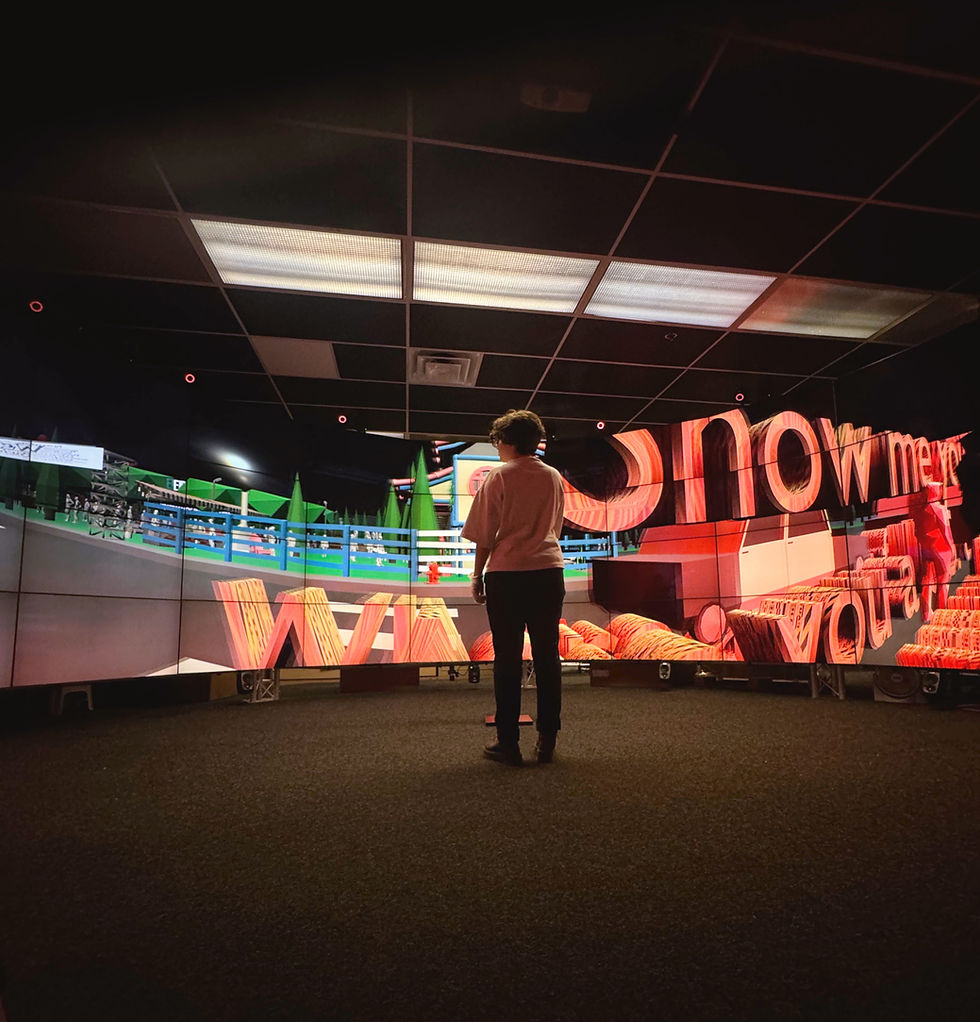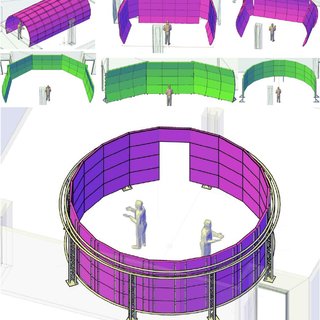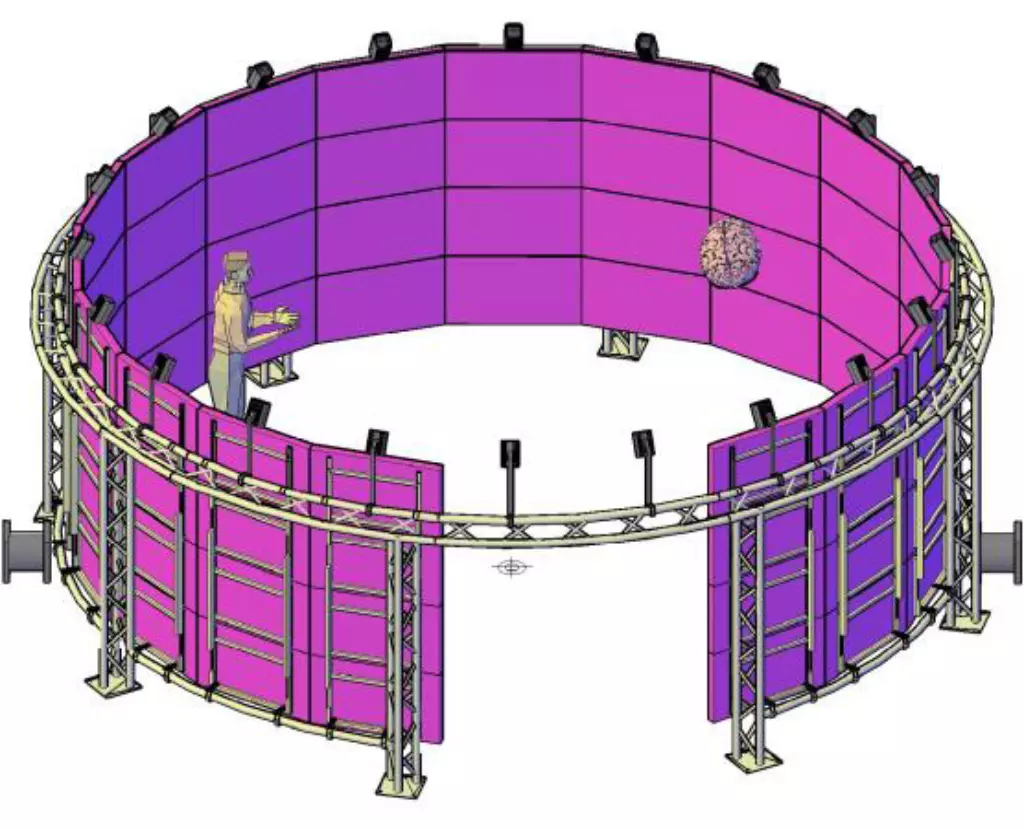
Immersive Design | Immigrant Journeys
Symbolic VR Narrative on Barriers and Belonging of the immigrants Right system
Immigrant Rights: Rewriting the System
Symbolic Immersive Design for SDG 10: Financial Insecurity in Immigrant Journeys
A Symbolic VR Narrative on Barriers and Belonging
Mehrnaz Amouei, MA, Amouei
University of Illinois Chicago, mamou3@uic.edu
Vedant Nandoskar, VN, Nandoskar
University of Illinois Chicago, vnand@uic.edu
Bahar Aryana, BA, Aryana
University of Illinois Chicago, barya@uic.edu

Immigrant Rights is a symbolic VR experience that visualizes the systemic barriers immigrants face—language, finances, and legal complexity. Set in CAVE2 and built in Unity, the project uses interactive typography and spatial storytelling to turn exclusion into embodied experience. Aligned with SDG 10, the work invites users to navigate, confront, and rewrite
inequality through immersive engagement.
CCS CONCEPTS • Immersive Storytelling, Virtual Reality, Sustainable Development Goals.
Additional Keywords and Phrases: Immigrant Rights, Symbolic Interaction, CAVE2, Unity3D, Multimodal Interaction, Social Justice, Narrative Design.
1- INTRODUCTION
The United Nations Sustainable Development Goal 10: Reduced Inequalities calls for social, legal, and economic inclusion of marginalized communities [1]. Immigrants often face barriers related to language, documentation, financial systems, and institutional discrimination. These experiences are difficult to express through traditional mediums. Virtual reality (VR), however, offers a powerful space for experiential learning and empathy-building [4]. Immigrant Rights is a symbolic
VR narrative that visualizes the journey of an immigrant navigating urban life in a new country. Designed using Unity and exhibited in the CAVE2™ immersive environment, the project uses theatrical metaphors, spatialized audio, and gestural interactions to represent barriers like language disorientation, financial insecurity, and legal complexity. The project draws from Design + Theater + Coding, a methodology that blends creative coding with performative storytelling to
explore real-world issues in symbolic form [2].

2- NARRATIVE STRUCTURE AND INTERACTIONS
The user progresses through four symbolic scenes. Each environment introduces specific obstacles and interactions that metaphorically correspond to real immigrant experiences.2.1 Language Barrier: Confusion to Comprehension The journey begins in a stylized city center. Buildings are covered in unreadable scripts (Devanagari, Greek, Arabic),and layered multilingual audio creates a disorienting soundscape. The player hears overlapping voices in unknown languages, evoking the cognitive overload many immigrants face in unfamiliar environments.
Interaction: As the player walks forward, signage and voices gradually fade away. This progression is symbolic of adaptation through persistence, observation, and support.
2.2 Financial Insecurity: The Economic Gap
The player next faces a deep chasm marked with words like “debt,” “unemployment,” and “rent.” A ramp ascends out of thechasm with glowing terms such as “education,” “literacy,” and “stability.
” This ramp symbolizes an ascent out of financial problems through positive attributes such as education, financial literacy, etc.
2.3 Legal Barrier: Know Your Rights
As the user moves ahead, they are stopped by a police force. The user can see flashing police lights, sirens, stop barriers, and large text blocking their way. The text represents statements like “Show me your documents”.
Interaction: The player sees the virtual documents and is reminded of the constitutional rights given to them even as an
immigrant. This moment emphasizes that legal literacy is essential to empowerment and safety.
2.4 Belonging: Celebration at The Bean
The destination is Cloud Gate (“The Bean”) in downtown Chicago. The player is welcomed by a multicultural crowd. Reflective surfaces allow players to see themselves within a diverse community. Interaction: A walk into this region triggers music and ambient celebration. This moment symbolizes visibility, acceptance, and shared joy.
CAVE2 as located at the University of Chicago at Illinois’ Electronic Visualization Laboratory
3- Typography as System and Symbol
Typography is not just a visual tool but a medium for emotional weight and interaction.
Franklin Gothic is used in civic and legal scenes, evoking authority and institutional language.
Noto Sans supports multilingual clarity, reflecting linguistic diversity and access.
Word size, motion, and proximity convey pressure and power. Words evolve as users act: oppressive phrases collapse, transform, or rise as allies, turning typography into a dynamic agent of resistance.
4- Development Tools and Implementation
Unity3D (C# scripting) for interactivity
Adobe Illustrator for typographic design
Autodesk Maya & Blender for 3D modeling
GitHub for version control and collaboration
CAVE2™ with GetReal3D and Omicron templates for deployment
5- Collaboration and Exhibition
This project was developed through participatory design, improvisation, and scene-based prototyping.
Vedant Nandoskar: Language and Legal scenes
Mehrnaz Amouei: Financial scene
Bahar Aryana: Belonging scene
Immigrant Rights was installed in the CAVE2, a 320° immersive space with 72 HD panels and full-body tracking. Over 30 participants—many with immigrant backgrounds—interacted with the experience, often relating it to their own journeys.
6- CONCLUSION
Immigrant Rights demonstrates how immersive VR can address SDG 10 by translating barriers into symbolic interaction. The journey—from disorientation to celebration—mirrors real immigrant experiences through emotional, metaphorical, and interactive design. The CAVE2 exhibition revealed that shared VR can spark dialogue, empathy, and reflection. As the project moves forward, we aim to expand the interaction set (e.g., in healthcare or education contexts), and
collaborate with community partners to use Immigrant Rights as an educational tool. Ultimately, the project shows how technology and storytelling can merge to challenge inequality—and offer belonging in virtual and real worlds.

REFERENCES
[1] United Nations Development Programme. “Goal 10: Reduced Inequalities.”
https://www.undp.org/sustainable-development-goals
[2] Daria Tsoupikova, Lance Nyhoff. “Design + Theater + Coding.” University of Illinois Chicago, 2020.
[3] Febretti, A., Nishimoto, A., Thigpen, T ., et al. “CAVE2: A Hybrid Reality Environment for Immersive Simulation and
Information Analysis.” IS&T/SPIE Electronic Imaging, 2013.
[4] Slater, M., & Sanchez-Vives, M. “Enhancing our lives with immersive virtual reality.
” Frontiers in Robotics and AI, 2020.
https://www.evl.uic.edu/datsoupi/2025_CC/index.html
Project Gallery


































